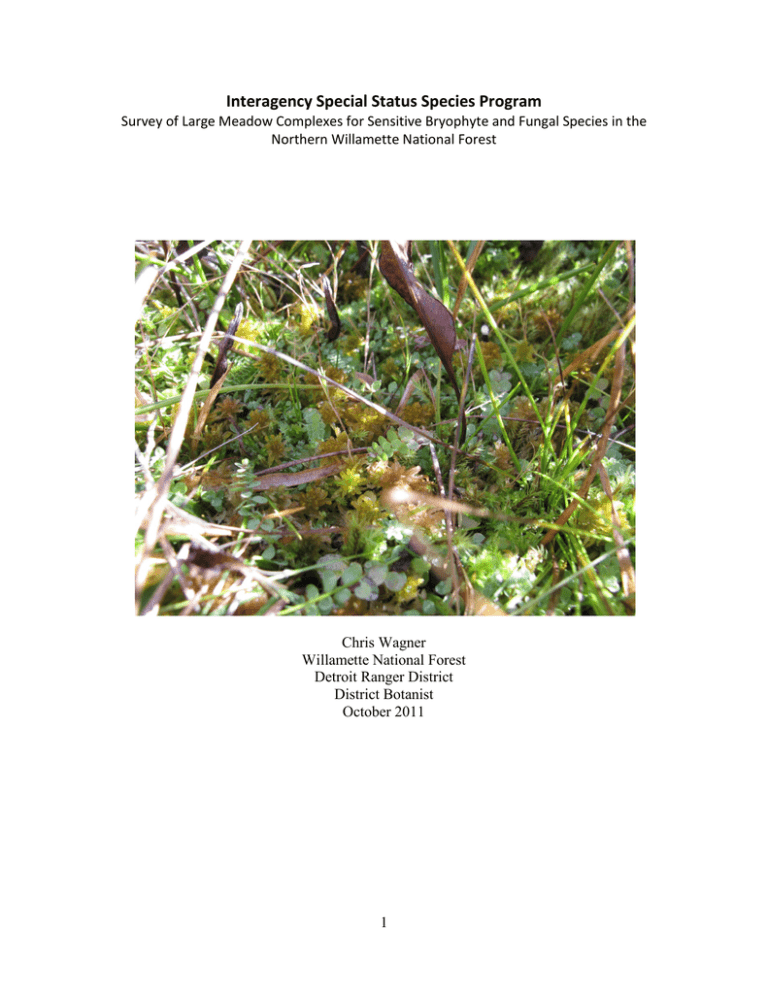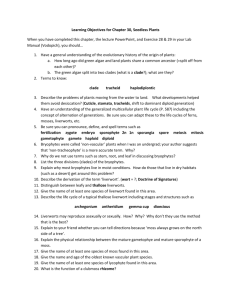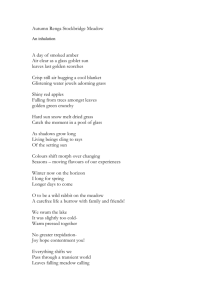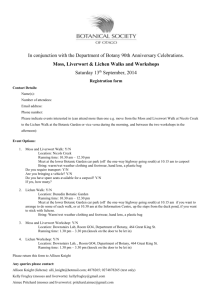Interagency Special Status Species Program
advertisement

Interagency Special Status Species Program Survey of Large Meadow Complexes for Sensitive Bryophyte and Fungal Species in the Northern Willamette National Forest Chris Wagner Willamette National Forest Detroit Ranger District District Botanist October 2011 1 Table of contents Introduction / Project Description……………………………………………………………..3 Sites Surveyed and Survey Results……………………………………………………………..4 Meadows, Information, Results…………………………………………………………………..9 Potential Future Survey Work………………………………………………………………………………14 References……………………………………………………………………………………….….…...15 ATTACHMENT 1: Regional Forester’s Special Status Species List for the Willamette National Forest (Revised 2008)……....................…………..16 2 Introduction Surveys were completed in 2010 and 2011 for large meadow complexes in the northern districts of the Willamette National Forest to determine whether any sensitive species of bryophytes or fungi are present. The type of habitat was also determined to clarify whether the habitat is a wet or dry meadow, bog or fen. Bryophyte identification was begun in 2010 with the first specimens collected and continued on through 2011 when most priority bryophytes were identified. The meadows selected represent the highest probability habitat for wetland bryophytes and fungi on Detroit and Sweet Home Ranger Districts. Some of these meadows may have been surveyed for vascular plant species in the past, but there are many new non-vascular sensitive species on the Willamette NF 2008 sensitive species list (see attachment 1) and additional species being being added to the proposed 2012 Regional Forester’s sensitive species list (unpublished). Meadows surveyed on the Detroit Ranger District included: Tule Lake meadow complex, Twin Meadows, Marion Lake meadow complex, Jo Jo Lake site, Wild Cheat Meadows, Bruno Meadows, Pigeon Prairie Meadow complex and Big Meadows. On the Sweet Home Ranger District Gordon Lake Meadows Complex was surveyed. Parish Lake bog has already been surveyed by bryologist, John Christy, for rare bryophytes. Additional meadows were added later because some of the meadows were drier than originally thought and deficient in bryoflora. Meadows added include Fisher meadow, and Boulder Ridge, Gale Hill Wetland area, Scar Mountain meadow and Pine Ridge wetlands. Project Description Surveys consisted of an intuitive-controlled survey to sample all habitats present within these meadows. Survey period was done during optimal times, after snow melt and throughout the spring, summer and fall. Comprehensive non-vascular plant lists were developed for each meadow surveyed (see Table 2). Simple vascular plant lists could not be created due to the time constraints of attempting to collect such a comprehensive amount of non-vascular plants. However, rare vascular plants were looked for as well. Table 1. Species targeted during surveys, but not limited to only these species. Forest sensitive Life form Rank Habitat Mythicomyces corneipes Fungi G2G4/S2 Wet areas with Salix Pseudorhizina californica Fungi G4/S2 seeps, moist areas, edges of creeks, marshes Barbilophozia lycopodioides Liverwort G5/S1 peaty soil Calypogeia sphagnicola Liverwort G4/S2 sphagnum stands Chiloscyphus gemmiparus Liverwort G1Q/S1 stream edges Helodium blandowii Moss G5/S2 and marshes Herbertus aduncus Liverwort G5/S1 mtn. top ledges? Jungermannia polaris Liverwort G4/S1 streams and rivulets Lophozia laxa Liverwort G4/S2 wetland 3 Forest sensitive Life form Rank Habitat Polytrichum sphaerothecium Moss G3G4/S1 subalpine parkland Tomentypnum nitens Moss G5/S2 wetland Tritomeria exsectiformis Liverwort -------- wet soil banks Carex diandra Gram G5/S1 many wetlands Carex lasiocarpa var. americana Gram G5T5/S2 marshes Carex livida Gram G5/S2 very wet Gentiana newberryi Forb G4/S2 moist, wetlands Additional Vascular plants to also look for Lycopodiella inundata Forb G5/S2 wetlands Ophioglossum pusillum Forb G5/S1 wetlands Rotala ramosior Forb G5/S2 wet, swampy Scheuchzeria palustris var. americana Forb Gram G5T5/S2 G4G5/S2 wetlands Schoenoplectus subterminalis wetlands Sites Surveyed and Survey Results Two hundred and twenty-four specimens were collected. One hundred and fourteen of these specimens were identified to species. Many of these were duplicate species leaving an actual list of 85 different species. One species is listed from the proposed 2012 Regional Forester’s list. The remaining 111 specimens were not identified to species due to the overwhelming number of collections and because these genera were known not to be rare or at least are very common. These species were mainly from the genera Pohlia, Dicranum, Bryum, Fontinelis, and Drepanocladus. There may be future species discovered out of these collections as identification continues. None of the “Additional sensitive vascular plants to look for” in the above list in Table 1 were documented. Species Documented There was 1 species proposed to be sensitive in the upcoming Regional Forester’s list update out of 7 total specimens (see Appendix A) documented within these meadows. This species has been confirmed as Rhyditiadelphus subpinnatus. A sighting form has been filled out for the sensitive species’ voucher and a new sensitive plant site will be entered into the NRIS TESP database. 4 Table 2. Comprehensive non-vascular plant lists for each meadow surveyed. Fisher Meadow Boulder Ridge Gale Hill Wetland 1 2 3 2 1,3, 5 Pine ridge lake wetlands JoJo lake site 2 1,2, 6 Scar mtn meadows Gordon lake Meadows 1,6 1 2 3 7 x Wild Cheat Meadow 1 6 Tule Lake Meadow Moss Moss Moss Moss Liverwort Liverwort Moss Moss Moss Moss Moss Moss Moss Moss Liverwort Liverwort Liverwort Liverwort Liverwort Liverwort Liverwort Liverwort Liverwort Liverwort Liverwort Moss Moss Liverwort Moss Moss Moss Moss Moss Moss Moss Moss Moss Moss Moss Moss Moss Moss Moss lichen Marion Lakes wetlands Alsia californiia Amblystegium varium Amblystegum juratzkanum Aulacomnium palustre Barbilophozia barbala Blepherstoma trichophyllum Brachythecium frigidum Brachythecium leibergii Brachythecium nelsonii Brachythecium occidentale Pohlia cruda Bryum Calleirgonella Calleirgonella cuspidata Calypogeia integristipula Calypogeia neesiana Calypogeia fissa Cephalozia bicuspidata Cephalozia catenula Cephalozia leucantha Cephalozia lunulifolia Cephalozia pleniceps Cephaloziella turnerii Chylosyphus polyanthos Chylosyphus profundus Claopodium bolanderi Claopodium whippleanum Conocephalum conicum Cratoneuron filicum Dicranum Dicranum fuscescens Dicranum rhabdocarpum Diplophyllum obtusifolium Drepanocladus Drepanocladus sordidus Eurhynchium oreganum Fontinalis antipyretica Fontinalis neomexicana Hamatocaulis vernicosus Heterocladium procura Hygrobiellia laxiflora Hylocomnium triquentris Hypnum circinale Hypogymnia physodes 1 6 1 6 7 Big Meadows Habitat types* Bruno Meadows Group Pidgeon Prairie Species 6 x x x x x x x x x x x x x x x x x x x x x x x x x x x x x x x x x x x x x x x x x x x x x x x x x x x x x x x x x x x x x x x x x x x x x x 5 x Scar mtn meadows Pine ridge lake wetlands Boulder Ridge Gale Hill Wetland Fisher Meadow JoJo lake site Gordon lake Meadows Wild Cheat Meadow Moss Liverwort Liverwort Liverwort Liverwort Moss Moss Moss Moss Moss Liverwort Liverwort Moss Moss Moss Moss Moss Moss Moss Liverwort Liverwort Liverwort Liverwort Liverwort Moss Moss Moss Moss Moss Moss Liverwort Liverwort Liverwort Liverwort Liverwort Moss Moss Moss Lichen Tule Lake Meadow Leucolepis acanthoneuron Lophozia incisa Marchantia polymorpha Marsupella emerginata Marsupella sphacelata Meesia triquentra Mnium spinulosum Mnium thomsonii Orthodicranum tauricum Orthotricum chryseum Pallavinicinia lyallii Pellia neesiana Philonotis fontana Plagiomnium insigne Plagiomnium venustum Plagionmium rostratum Pohlia Pohlia ludwigii Polysticum juniperinum Ptilidium californicum Ptilidium pulcherrimum Radula Radula bolanderi Radula complanata Rhizomnium glabrescens Rhizomnium magnifolium Rhodobryum roseum Rhytidiadelphus subpinnatus Rhytidiadelphus triquetrus Rhytidiopsis robusta Riccardia latifrons Scapania Scapania americana Scapania bolanderi Scapania curta Scoularia aquatica Sphagnum Sphagnum bartlettianum Sticta weigelii Marion Lakes wetlands Group Big Meadows Species x Bruno Meadows Moss Pidgeon Prairie Leskea polycarpa x x x x x x x x x x x x x x x x x x x x x x x x x x x x x x x x x x x x x x x x x x x x x x x x x x x x x x x x x x x x x x x x x x x x x x x *Habitat types= Wet meadow(1), Dry meadow(2), fen(3), bog(4), ponds(5), marsh(6), peat(7) 6 Rhyditiadelphus subpinnatus. According to Bryophyte Flora of North America, Vol 2 (Rohrer 2004), “ For the past several decades, many Canadian and European bryologists have recognized Rhytidiadelphus subpinnatus as a species distinct from R. squarrosus, whereas American bryologists have held to the traditional concept of a broadly circumscribed R. squarrosus that includes R. subpinnatus.” T. Koponen (1971, as cited in Rohrer 2004) and H. A. Crum and L. E. Anderson (1981, as cited in Rohrer 2004) have provided contrasting opinions and worthwhile discussion on the species problem. In North America R. subpinnatus is by far the more widespread and abundant taxon. The two taxa are distinct ecologically, but intergrade somewhat morphologically. The most troublesome specimens are those from a few isolated subalpine sites of the Canadian West. The plants grow in wet areas on the forest floor or along the margins of lakes and hot springs in alpine Photo 1. Rhyditiadelphus subpinnatus meadows or in open Abies lasicarpa stands. Although their leaf morphology is clearly that of R. subpinnatus, these specimens are less branched and their leaves are more strongly squarrose and crowded. As W. B. Schofield and S. S. Talbot (1991, as cited in Rohrer 2004) noted, “within one colony, plants resembling both taxa can be found.” Rhyditiadelphus subpinnatus is not currently on the Region 6 Regional Forester’s sensitive species list, but it is proposed for the 2012 list update. Recently DNA testing was completed, and it has been determined to be in fact a different species from R. squarrosus. I do believe that this species is under- collected and many times passed over as R. squarrosus . It has been documented along the Santiam River, on a side channel of a fen like area. This species has been known to prefer peaty sites like this. It has only been documented twice in Oregon and once in Washington. This new site makes the third known sighting in Oregon, and according to bryologist Dr. David Wagner (personal communication, 2010) it is the second known site on the Detroit Ranger District. R. subpinnatus was documented within the Tule Lake meadows. The habitat was the same as described above, growing amongst other mosses within a peat-like environment. This area was actually tested to determine whether or not it is a fen, and it tested positive. A fen is a type of wetland fed by mineral-rich surface water or groundwater characterized by water chemistry, which is neutral or alkaline, with relatively high dissolved mineral levels but few other plant nutrients. Fens appear to be rare on the Willamette National Forest. Though there are small peat-land like areas, very few have been tested as official fens and the ones that have been tested on the Detroit Ranger District usually always fail. This site is the first positive tested fen in Detroit Ranger District. 7 Meadows Photo 3 Pidgeon Prairie Pidgeon Prairie Pidgeon Prairie meadow (cover photo and Photo 3) consists of wet sedge marshland with outliers of wet meadow habitat. There are no bryophytes submerged in the drenched marshland. All bryophytes were collected on the outskirts where habitat is more suitable for a variety of bryophyte species. There were many specimens from this particular meadow that have not yet been identified to species. More time is needed. Just an overview of what was observed, there is habitat for Tomentypnum nitens and possibly more species. Mt Bruno Meadows, Wetlands Map 1 Bruno Meadows is a unique meadow with several different habitat types: sedge marsh, peatland, and wet meadow. Some potential fen sites within the meadow tested negative. However, there are many more sites within the meadow that may in fact test positive if comprehensive fen inventories occur. The vascular plants within this meadow have been documented well. Bryophyte diversity is high with peatland types of bryophytes such as Sphagnum, Meesia triquentra and several Drepanocladus species. No rare bryophytes have been documented to date. 8 Map 2 Big Meadows Big meadows is an open carex meadow with lots of shrubs and Picea engelmannii and Pinus contorta. The number of nonvascular species was much lower than expected with only the basic bryophytes. No rare bryophytes have been documented to date. Marion Lake Wetlands The eastern portion of wetland area has a skunk cabbage swamp. The southern portion has springs, creek channels and standing water pools. All contain skunk cabbage swamps and sedge meadows as well as some boggy areas beneath the alders. This area was burned in the 2003 B&B fire; some wetlands were severely burned on the east side of the lake. No impressive bryophytes were documented. These wetlands were mostly dominated by Fontinalis neomexicana. No rare bryophytes have been documented to date. Map 3 9 Tule Lake Meadows Map 4 Tule Lake meadows is very interesting. It is separated by a road but remains connected hydrologically by the culvert beneath. The main meadow drains into the small lake. At the top of the meadow is a dry meadow which grades into wet pockets and channels, seeps and wet meadow below. Closer to the road is where the first tested and confirmed fen on the district is located (see red outline in photo). Fens appear to be rare on the Willamette National Forest. Though there are small peatland-like areas, very few have been tested as official fens and the ones that do get tested on the Detroit usually always fail, not quite meeting the national soils standards required to call it a fen. At the small lake margin/meadow is fen-like area full of peat mosses and other bryophytes. Within this fen is a high diversity of non-vascular species with up to two different sphagnum (not yet identified). Most of the bryophyte collections have been identified with more still need to be completed. Tule Lake Meadows has one rare bryophyte identified. This species is Rhytidiadelphus subpinnatus. R. subpinnatus was also collected at the lake meadow with sphagnum. Map 5 Wild Cheat Meadow Mostly a dry meadow with small pockets of moisture. This meadow was extremely unimpressive with bryophytes and diversity in general. Few of the basic mosses were documented, but nothing special at all. 10 Map 5 Gordon Meadows Gordon Meadows was a very large meadow encompassing an area 2.5 miles wide west to east. The amount of this meadow covered with respect to its size was minimal. There were several collections made within the forest, on the trail, on the way to the meadow and along the side of the meadow on the west side of the middle meadow shown here on the map 5 and on the north side as well. The diversity within this old growth forest was very high. Many collections were made outside of the meadow and inside the meadow. Some of these forested areas proved to be very interesting in bryophyte diversity with seepy areas and well-shaded forest containing prime habitat for many rare species. No rare species within the meadow portions surveyed were found. Rhyzomnium nudum has been previously documented in this area, but Rhyzomnium species collections from this project were identified and none were R. nudum. This meadow will need many more days of survey in order to fully collect all potential sites. This can be a good intensive survey project for the future. There probably are more species to be found in this area. Photo 4 Jo Jo Lake Wetland Jo Jo Lake Wetland Jo Jo Lake has a small wetland and wet meadows around it with a small peatland. Fen tests were negative, but it does contain bryophytes that prefer peatland type of environment such as Sphagnum and Drepanocladus mosses, Drosera and Potentilla palustris. Up from the shore of the lake is more decaying wood and oldgrowth forest. No rare bryophytes were collected from Jo Jo lake wetland area. 11 Fisher Meadow Fisher meadow was a previously undescribed meadow that did not exist on the district’s current special habitat layer. It’s a wet meadow that appears to have been logged over in a large sized clearcut. There are peaty soils and a high diversity of bryophytes including Drepanocladus mosses. The survey was conducted late in the season. A future survey during optimal season times should be done to determine if there are any rare vascular species. Map 6 Map 7 Boulder Ridge / Gale Hill Wetland The largest meadow surveyed was located in the middle of this wetland complex. It is located in a drainage and appears very healthy and well-used by wildlife. It contains a high diversity of plant species and bryophytes. No unique habitats were documented within the meadow besides it being a wet meadow. No rare bryophytes were documented. Photo 5 Interesting liverwort Scar Mtn Meadows, Wetland Various meadow habitats occur throughout this meadow. It is mostly dry vegetation, dominated by shrubs. Drepanocladus is documented indicating peat ultramafic soil substrates. One particular species currently being worked on but not yet identified (see photo 5) initially keyed to lophozia. First attempts to identify it failed so it was put aside. I will attempt this again. 12 No rare bryophytes have been documented at Scar Mtn Meadows wetland at this time. Pine Ridge Meadow Pine Ridge lake wetlands turned out to be more like sedge marshes than any wet meadow habitats. The primary dominant bryophyte was Fontinalis neomexicana covering the ground. No rare bryophytes were documented at this time. Map 8 Potential Future Survey Work More time is needed to identify so many collections than was allotted for this project. Future sensitive species surveys could focus upon all large meadow complexes across the Willamette National Forest, but with lots of additional time budgeted for nonvascular species collection identification. Some of the focus can be on the outskirts of these meadows unless seepy/peaty locations are identified within the meadows. For someone like myself that has been identifying non-vasculars for many years (but not expert status), I can key out 1-4 mosses in an hour depending on the species I am working with. That can be 25-100 hours for 100 specimens (1-3 weeks of keying straight). For most botanists that do not key out mosses, it can take 1-2 hours per moss. As for the meadows that need to be surveyed, most botanists already have timber sale surveys and other workloads. I would suggest two years of meadow surveys with an additional year or two to complete bryophyte identification. Although I was able to identify just over half of the total collection, more time is needed to continue keying out the rest. A combined effort could include Fen inventories, which is a matter of peat depth test pits, pH test and vegetation type, to determine whether fens exist in any of these meadows. 13 References Christy, J. and D. Wagner. 1996. Guide for the identification of rare, threatened or sensitive bryophytes in the range of the northern spotted owl, Western Washington, Western Oregon and Northwestern California. Unpublished Report. Bureau of Land Management, Portland, Oregon. Rohrer, J. R. 2004. Bryophyte Flora of North America, Vol. 2, Rhytidiadelphus subpinnatus. Provisional Publication, eflores.org Available at: http://www.efloras.org/florataxon.aspx?flora_id=50&taxon_id=250062144 14 ATTACHMENT 1: Regional Forester’s Special Status Species List for the Willamette National Forest (Revised 2008). Species of federal, state, and local importance are included on the R-6 list. Species Vascular Plants Agoseris elata Arabis hastatula Arnica viscosa Asplenium septentrionale Botrychium minganense Botrychium montanum Botrychium pumicola Bridgeoporus nobilissimus Calamagrostis breweri Carex abrupta Carex capitata Carex diandra Carex lasiocarpa var. americana Carex livida Carex scirpoidea var. stenochlaena Carex vernacula Cicendia quadrangularis Cimicifuga elata Coptis trifolia Corydalis aqua-gelidae Elatine brachysperma Eucphalus gormanii Eucepahlis vialis Frasera umpquaensis Gentiana newberryi Hieracium horridum Iliamna latibracteata Lathyrus holochlorus Lewisia columbiana var. columbiana Lupinus sulphureus var. kincaidii Lycopodiella inundata Lycopodium complanatum Ophioglossum pusillum Pellaea andromedaefolia Poa rhizomata Occurrence on WNF ONHP Status State Status Federal Status S D S S D D S D D D D S S 2 1 2 2 2 2 1 LT 1 2 2 2 2 2 S D 2 2 WM RO S D D S D S D S D D D S D D 2 2 1 2 1 2 1 1 1 2 2 2 1 2 WM WM CF WM,CF RZ,CF SW RS CF MM MM RO CF,RZ MM RS S 1 LT D D D S D 2 2 2 2 2 15 SofC C C LT C SofC LT MM,DM RO RS RO RZ,CF RZ,CF HV CF MM,RZ WM HV WM WM MM,DM WM CF WM RO CF Habitat Types Occurrence Species on WNF Polystichum californicum D Potentilla villosa D Rhynchospora alba D Romanzoffia thompsonii D Rotala ramosior S Scheuchzeria palustris D var. americana Schoenoplectus subterminalis D Sisyrinchium sarmentosum S Utricularia minor D Utricularia ochroleuca D Wolffia borealis S Wolffia columbiana S Lichens Bryoria subcana D Chaenotheca subroscida D Dermatocarpon meiophyllizum S Hypogymnia duplicata S Leptogium burnetiae S Lobaria linita D Nephroma occultum D Pannaria rubiginosa D Peltigera pacifica D Pilophorus nigricaulis D Pseudocyphellaria mallota D Pseudocyphellaria D rainierensis Ramalina pollinaria D Tholurna dissimilis D Usnea longissima D Fungi Alpova alexsmithii Boletus pulcherrimus Bridgeoporus nobilissimus Choiromyces venosus Chroogomphus loculatus Cortinarius barlowensis Cudonia monticola Cystangium idahoensis Destuntzia rubra Gastroboletus imbellus Gastroboletus vividus D D D S D D D D D D D ONHP Status 2 2 2 1 2 2 2 1 C 2 2 2 2 State Status SofC Federal Status RO RS,RO SP RS RZ, SW WM SW,WM MM,DM SW SW SW SW 2 3 3 3 not listed 2 4 2 not listed 2 2 4 RO CF CF,RZ 2 2 3 CF,RZ CF CF,RZ 1 1 1 2 1 2 3 1 1-ex 1-ex 1 CF CF CF CF CF CF CF CF 16 Habitat Types CF CF RZ on rock CF CF RO CF CF CF CF CF CF Occurrence Species on WNF Gomphus kaufmanii D Gymnomyces fragrans D Helvella crassitunicata D Leucogaster citrinus D Mythicomyces corneipes D Octaviania macrospora S Phaeocollybia attenuata D Phaeocollybia dissiliens D Phaeocollybia pseudofestiva D Phaeocollybia sipei D Pseudorhizina californica D Ramaria amyloidea D Ramaria aurantiisiccescens D Ramaria gelatiniaurantia D Ramaria largentii D Ramaria spinuulosa S var. diminutiva Rhizopogon exiguous S Rhizopogon inquinatus D Sowerbyella rhenana D Stagnicola perplexa S Bryophytes Andreaea schofieldiana Barbilophozia lycopodioides Brachydontium olympicum Bryum calobryoides Calypogeia sphagnicola Conostomum tetragonum Encalyptra brevicollis Encalyptra brevipes Entosthodon fascicularis Gymnomitrion concinnatum Helodium blandowii Herbertus aduncus Jamesoniella autumnalis var. heterostipa Jungermannia polaris Lophozia laxa Marsupella emarginata var. aquatica Polytrichum sphaerothecium Rhizomnium nudum Schistostega pennata ONHP Status 3 1 2 3 2 1-ex 4 3 3 3 2 2 4 3 3 1 2 2 3 2 State Status Federal Status CF CF CF CF CF CF CF CF CF CF CF CF CF CF CF CF CF CF CF CF S D S D D S S S S S S S D not listed 2 not listed not listed 2 not listed not listed not listed not listed 2 not listed 2 1 D D D 2 2 2 RZ SP SW S D D not listed 2 2 CF CF 17 Habitat Types RO RO RO, RS RO, RS SP RO, RS RO RO RO RO, RS SP RO, CF RZ, SW RO, RS Species Splachnum ampullaceum Tayloria serrata Tetraphis geniculata Tetraplodon mnioides Tomentypnum nitens Tritomaria exsectiformis Occurrence on WNF S S S D D S ONHP State Status Status not listed not listed 2 not listed not listed 2 Federal Status Habitat Types DG DG CF Occurrence on Willamette National Forest: S = Suspected D = Documented Oregon Natural Heritage Program (ORNHP): 1 = Taxa threatened or endangered throughout range. 2 = Taxa threatened or endangered in Oregon but more common or stable elsewhere 3 = Species for which more information is needed before status can be determined, but which may be threatened or endangered (Review). 4= Species of concern not currently threatened or endangered (Watch). Oregon State Status: LT = Threatened LE = Endangered C = Candidated Federal Status: These plant species were originally published as CANDIDATE THREATENED (CT) in the Smithsonian Report, Federal Register, July 1, 1975, or as PROPOSED ENDANGERED (PE) in a later report, Federal Register, June 16, 1976. The latest Federal Register consulted was dated September 30, 1993. Updated listings appear periodically in the Notice of Review (USFWS); the status of several species is categorized as follows: LE = Listed as an Endangered Species LT = Listed as a Threatened Species PE = Proposed as an Endangered Species PT = Proposed as a Threatened Species C = Candidate for Listing as Threatened or Endangered SofC = Species of Concern; taxa for which additional information is needed to support proposal to list under the ESA. Habitat Types: MM = Mesic meadows WM = Wet meadows DM = Dry meadows RZ = Riparian zones, flood plains CF = Coniferous forest SP = Sphagnum bogs or fens RS = Rocky slopes, scree RO = Rock outcrops, cliffs DW = Dry open woods HV = High volcanic areas SW = Standing water DG = Dung 18







